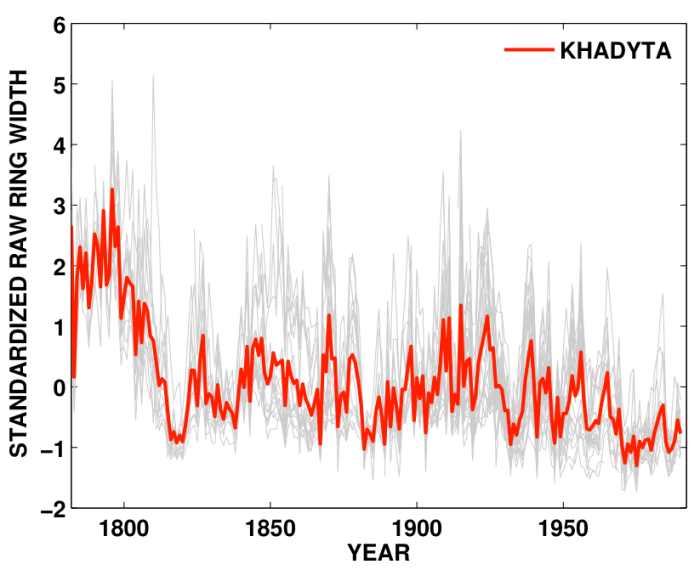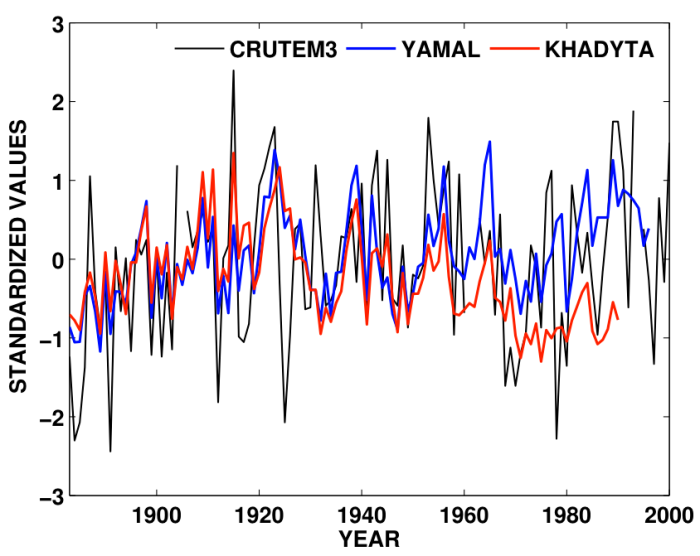Yamal Emulation II: Divergence
As I mentioned in my previous post, the Khadyta River chronology appears to suffer from the classic signs of what dendrochronologists have come to call ‘the divergence problem‘. Before I continue, however, I should emphasize a few points.
[1] I didn’t collect the Khadyta River chronology. Neither did Steve McIntyre. The problem with treating tree ring chronologies as nothing more than received time series downloaded from the internet to be manipulated in various ways is that the context of the original investigators can be lost. Moreover, there are several subdisciplines within dendrochronology that collect tree ring data for different reasons, and in their fieldwork emphasize different site or individual tree characteristics during sampling.
[2] In any case, the concept of what comprises a single ‘site’ is ill defined (Wikipedia covers this in the context of archaeology). There is no hard-and-fast rule for how to geographically delimit which group of individual trees belong to a given chronology site.
Let’s return to Yamal and Khadyta. Remember that adding the Khadyta raw data to that from Yamal gives us the following situation (zooming in on the last century and a half now):

What becomes clear immediately is that the two chronologies diverge in approximately the early 1970s. Why does this occur?
We can look at the raw data from each site separately. First, I’ll graph the standardized raw data (to account for differences in tree size and mean growth rate) and their mean from Khadyta:

Again, what jumps out here is that the trees at this size show a decrease in growth in the late 1960s and early 1970s. The step change that the mean takes jumps out at me immediately.
Lets look at the same type of plot for the Yamal data:

Here, the persistent low growth years seen at Khadyta after 1970 are not present in the majority of trees (although, interestingly, perhaps in a few of them). As a consequence, the mean raw value continues to climb through the 1980s and 1990s.
We can now look at the two mean raw value time series together, as well as compare them to the gridded temperature data from the region. For this purpose, I’ve extracted summer (JJA) temperature for the grid box [65-70N, 65-70E] from CRUTEM3— a bit crude, but for the comparison to the raw mean data, it will serve our purpose:

Considered individually, and remember here with no detrending, both mean time series track each other — and the gridded summer temperature — well at both low and high frequencies. The two mean tree ring series diverge starting in the 1960s. Both track years with lower temperatures in the late 1950s and 1960s, but by the 1970s, Khadyta fails to mirror regional warming in the gridded summer temperature. Yamal continues to track increasing temperatures from the 1970s through the 1990s.
This quick-and-dirty analysis emphasizes a few points. Khadyta River does display the divergence problem, in that it ceases to track temperatures as it did from 1883 to the 1960s. At first glance, in this case, the divergence doesn’t seem to be related to detrending [PDF], and really does seem to reflect a decline in growth in the most recent decades. Second, adding Khadyta River data to Yamal is unlikely to reflect temperatures in the region more accurately.
I want to emphasize that neither Yamal nor Khadyta River are ‘the problem’ — divergence is the problem, and for this reason is a major [PDF] area of focus in dendrochronology. Relatively little more can be said about the specific case of Yamal at this point — I’ll leave that to the scientists working in this part of the world — but even my quick review of these data here shows that including Khadyta River raw data in the Yamal chronology does not result in a more accurate nor precise understanding of past temperatures in the region. This isn’t to say that some time in the past that Yamal didn’t experience divergence (this after all is a large part of the concern about divergence), but we can clearly see that Khadyta River does exhibit modern divergence.
A very interesting paper with relevance to this issue appears to be in press in Global Change Biology:
Esper, J., Frank, D., Buntgen, U., Verstege, A., Hantemirov, R., and Kirdyanov, A. (2009). Trends and uncertainties in Siberian indicators of 20th century warming. Global Change Biology, in press [subscription wall]
Check it out if you can.
Bravo! Let me be the first to congratulate you on a very helpful analysis. The technical issues are much clearer to me now.
Although I must say, I had commented elsewhere that one can not just throw tree-ring data sets together willy-nilly. Thanks for showing *why* this is problematic in this case.
Deep Climate
October 6, 2009 at 1:23 am
[…] the second post, DO explores the “divergence” problem and compares the two series to actual temperature as recorded in the appropriate CRUTEM temperature […]
“Delayed Oscillator” on divergence « Deep Climate
October 6, 2009 at 3:29 am
Excellent stuff!
“Here, the persistent low growth years seen at Khadyta after 1970 are not present in the majority of trees (although, interestingly, perhaps in a few of them).”
I wonder if there’s a way to check if these few Yamal trees showing low growth are exactly those few that McIntyre left there? I mean that he removed 12 Yamal trees out of 17 (according to numbers given by him), so I have to wonder if the low growth ones are the 5 that weren’t removed (I bet they are).
Ari Jokimäki
October 6, 2009 at 8:34 am
Hi Ari,
Thanks — interesting idea, I’ll see if I can check it out (and assess the impact) for you.
delayedoscillator
October 6, 2009 at 11:22 am
Thank you for taking the time to show why people like McIntyre need to do science the scientific way and the audit way.
My concern is that once this is all over and SM is shown to be wrong, will it get the same press/blog coverage?
Scott Mandia
October 6, 2009 at 10:15 am
Hi Scott,
I think the issue of divergence in previously temperature-sensitive tree ring chronologies like Khadyta River is a really interesting research topic, so I find it a shame that instead of approaching this issue scientifically, partisans on one side are using it for tawdry political gain. Unfortunately, as you suggest, the nitty-gritty of scientific inquiry will seldom gain the exposure that quick manufactured controversy does in the press.
delayedoscillator
October 6, 2009 at 11:20 am
Excellent work.
By the way, I am not a RealClimate commentator, only someone who has worked quite a lot on time-series analysis.
Steve McIntyre’s work, in the area that I know, has some real problems, and in trying to counter my criticisms he has ended up contradicting his own data.
In the end, though, it will be work just like this that will show that he hasn’t any science case.
Tom P
tom0p
October 6, 2009 at 11:18 am
Thanks for your analysis. When these polemics arise, even if they don’t have a significant impact, in the end, I always look for a perspective on the technical details, and with that respect I think that this article is the best until now on this Yamal subject.
Why summer temperatures instead of annual average?
(thanks in advance)
climafuturo
October 6, 2009 at 6:12 pm
According to this and this treering growth and temperature correlates during june/july and the russians therefore make a june/july reconstruction. The temperature trend is somewhat higher for june/july than june – august.
dumskalle
October 6, 2009 at 6:41 pm
Yes, correct. Growth at these sites is most strongly linked to June/July temperature (which is why I noted that my use of JJA was a bit crude)
delayedoscillator
October 6, 2009 at 8:11 pm
I recall that MXD was a better temperature proxy than ring width, at least in some cases.
wmconnolley
October 7, 2009 at 12:01 pm
Hi William,
Yes, correct. In many cases, maximum latewood density (MXD) has a stronger summer temperature signal than ring width. I might try and do a post on this at some point.
delayedoscillator
October 7, 2009 at 12:25 pm
Actually, not so rude since Briffa 2008 used the same method (CRU grid boxes) in Fig. 1(a) – Appendix A:
Click to access 2269.full.pdf
climafuturo
October 9, 2009 at 7:00 pm
Well, it felt crude when I did it … 🙂 Actually, I mostly mean ‘crude’ in the sense that the season of climate response is mostly June-July (not JJA), I believe. Nothing wrong with using gridded data.
delayedoscillator
October 12, 2009 at 10:50 pm
[…] https://delayedoscillator.wordpress.com/2009/10/05/yamal-emulation-i/ https://delayedoscillator.wordpress.com/2009/10/05/yamal-emulation-ii-divergence/ http://deepclimate.org/2009/10/04/climate-auditor-steve-mcintyre-yamal/ […]
Kylmää vettä MOT:n niskaan « Gaia
November 9, 2009 at 7:39 am